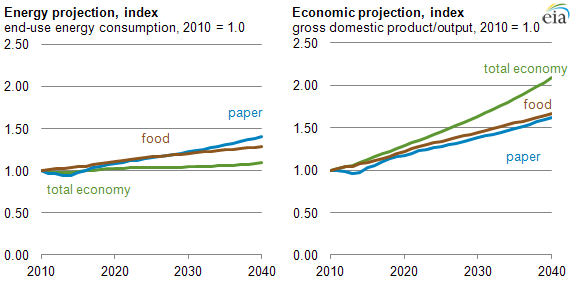
Food and paper account for 3.4% of nation’s energy use

The industrial sector, which encompasses manufacturing, mining, agriculture, and construction, is responsible for nearly a third of total energy use in the United States. About half of total industrial energy use is in energy-intensive manufacturing, including food and pulp and paper manufacturers. These industries produce a variety of consumer products, such as the food on grocery store shelves or the paper in your printer, and commodity products, such as flour used by commercial bakers or paperboard used to make cardboard boxes for shipping. These industries accounted for 3.4% of the nation's energy use in 2010, while providing about 3.3% of the nation's gross output of goods and services in the same year.
Food output and energy consumption were relatively flat in recent years. However, both output and energy consumption have declined for the pulp and paper industry over the past decade. The food industry uses less energy, but its diverse activities include a wide range of energy intensities, depending on the product. For example, wet corn milling and sugar manufacturing are an order of magnitude more energy intensive than the dairy industry. Over the long term, EIA projections show a declining contribution from both of these plant-based industries to the economy, but an increasing share of energy consumption (see chart below).

The most recent EIA manufacturing sector survey data are available in the Manufacturing Energy Consumption Survey (MECS2010). For more discussion of the industrial sector and individual industries, see EIA's Industry Analysis Briefs and the Annual Energy Outlook 2013 (AEO2013).